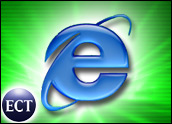
Microsoft rolled out the second beta of its upcoming Web browser, Internet Explorer 8 (IE8), Wednesday. When finalized, IE8 will be the first new version of the browser the software maker has released since 2006.
While the browser looks much the same, Microsoft has been tinkering under the hood to bring IE users new features and functionality.
“It’s great to see Microsoft moving forward with IE and trying to innovate in the browser. They are making the correct choices regarding standards support and privacy,” Matt Rosoff, an analyst at Directions on Microsoft, told TechNewsWorld.
With the eighth version of Internet Explorer, Microsoft software developers focused on three key themes — everyday browsing, safety and the platform — according to Dean Hachamovitch, general manager of IE8.
The release of IE8 Beta 2 comes nearly six months after Microsoft released the initial beta to developers in March. It is available in English, German, Japanese and Simplified Chinese for Windows XP, Windows Vista, Windows Vista x64, Windows Server 2003 and Windows Server 2003 x64.
Browser for Every Day
As Microsoft engineers looked at how people surf the Net, according to Hachmovitch, one thing that became clear was that the majority of user activity beyond the Web page involved tabs and navigation.
As a result, IE8 features a redesigned New Tab page that allows users to perform common tasks by clicking links on the New Tab page. Microsoft has also revamped the Tab Groups functionality. When one tab is opened from another, the new tab is placed next to the originating tab, and both are then marked with a colored tab. This enables users to quickly identify which tabs contain Web pages with related content, the company said.
“The launching of linked articles in new tabs coupled with the automatic grouping and color coding is probably the killer feature for me,” Rob Enderle, principal analyst at the Enderle Group, told TechNewsWorld. “I hate losing the page I’m looking at when I click on a link, and there is a huge architecture change here where rather than always navigating away from a page, you tend to — with IE8 — stay on the page but still see additional information.”
Another new feature is IE8’s Smart Address Bar. Leaving behind the static URL bar of old, Microsoft has created the Smart Address Bar that — like the Awesome Bar in Mozilla’s Firefox — will match URLs (uniform resource locaters) in the user’s site history with what is typed into the Address Bar. Results include content in a user’s favorites and feeds. The Smart Address Bar also has the capability to search the title, Web address and favorites folders.
“This means that you’ll find sites even if [you] type something other than just the first part of the Web address. To make it easier to find what you’re looking for, we group the results and highlight the matched text,” Paul Cutsinger, IE8 lead program manager, wrote on the IE8 blog.
The Smart Address Bar will give Firefox’s Awesome Bar a run for its money, according to Enderle.
“The smart address bar appears to go farther than the very popular Firefox ‘Awesome Bar.’ What it does differently is that when it displays addresses while you type one in, it groups them, making the feature vastly more useful,” he said.
Performance, Safety and the Platform
Engineers at Microsoft took a double-pronged approach to boosting performance in IE8, looking at performance in both the lab and the real world. IE8, according to Hachamovitch, is much faster than IE7 on many sites.
In terms of performance in the real world, the browser’s new tab functionality, Smart Address Bar, Favorites bar, Search box, Accelerators and Web Slices are aimed at making daily browsing simpler and quicker.
Users can use Accelerators to search, map, e-mail, translate or share content from any Web page they view with one click. They remove the need to cut and paste content or links in an e-mail or the Address bar. Microsoft takes care of that with a range of Accelerator buttons.
With Web Slices, users can subscribe to portions of their favorite Web sites and keep up-to-date with frequently updated sites from the Favorites Bar. When new information is added to a selected page or site, the Web Slice will become highlighted. Clicking on a highlighted slice will open a preview of the updated page.
Another feature that adds speed to a user’s surfing experience is IE8’s new Visual Search feature, which enables users to type in a search term and see results that include pictures, if they’re available.
On the safety front, IE8 Beta 2 includes the SmartScreen Filter and additional protections from phishing and malware. Engineers have also added the XSS Filter feature that makes reflected / “Type-1” Cross-Site Scripting (XSS) vulnerabilities — a growing threat vector — much more difficult to exploit from within the browser.
In addition, the InPrivate functionality, announced earlier this week, gives users the ability to control whether IE saves their browsing history, cookies and other data. The feature also enables users to block incoming third-party content and some types of advertising.
“Standout features for me include InPrivate browsing and Accelerators (formerly known as “Activities”), which can save a lot of time that would otherwise [be] spent opening new tabs and possibly copying and pasting data into them,” said Direction on Microsoft’s Rosoff.
Microsoft has also worked to make IE8 more interoperable with other Web browsers and Web standards. The company has also added CSS (cascading style sheets) 2.1 support, improved document object model and HTML 4.01. It’s also added new navigation features for asynchronous JavaScript and XML (extensible markup language) applications.
“The improvements in compatibility mean fewer problems with pages that weren’t optimized for IE, and this alone will probably reduce substantially the movement from IE to alternatives,” Enderle pointed out.
Areas of Improvement
While IE8 Beta 2 is a great move forward for Microsoft, Rosoff said, one area the company could do a better job with is installation.
“The installation process took a bit longer than I expected and required a reboot. I’d contrast that with the very clean and quick Firefox installation process. But it’s probably unavoidable given IE’s integration with Windows at some fairly low levels,” he noted.
Both Enderle and Rosoff said IE8 will be a competitive release able to go toe-to-toe with Mozilla’s Firefox.
“Firefox and IE is where the battle is being fought, and IE remains the dominant product. I think this release should be enough to stop folks from leaving IE to go to Firefox, particularly given some of the problems with the latest Firefox release,” said Enderle.
“I can’t think of any obvious places where it lags behind these other browsers. Firefox users in particular might want to give it another look and see if the new features are enough to make them switch,” Rosoff concluded.




















































